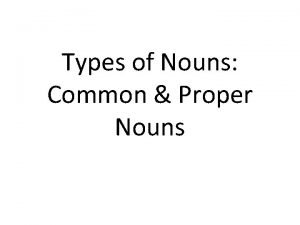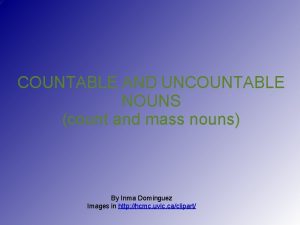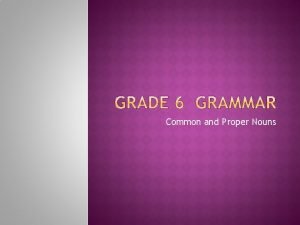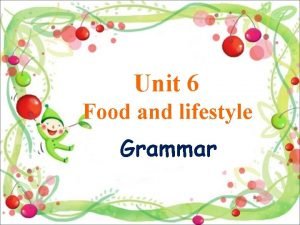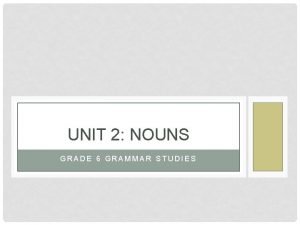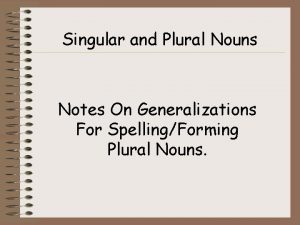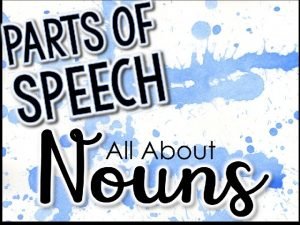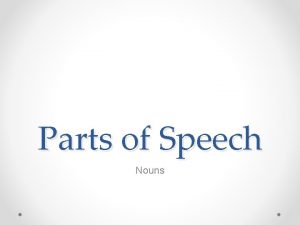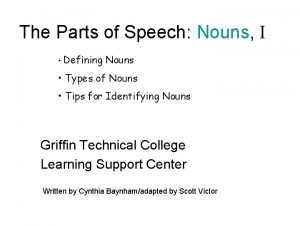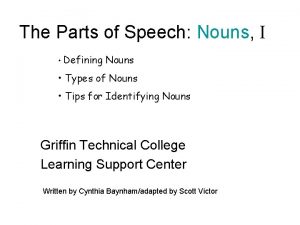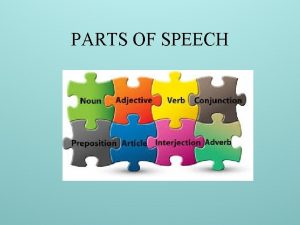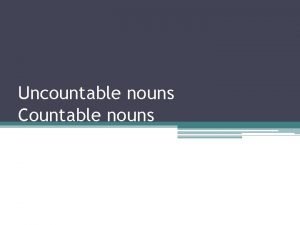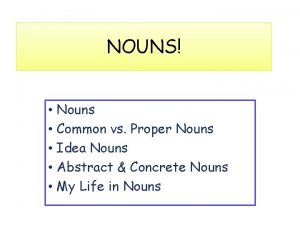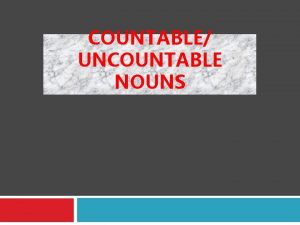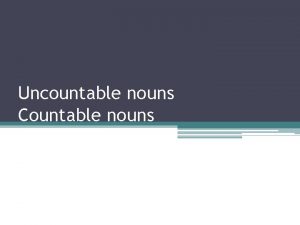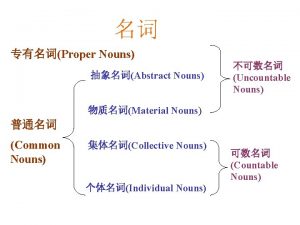The Parts of Speech Nouns I Defining Nouns














- Slides: 14

The Parts of Speech: Nouns, I • Defining Nouns • Types of Nouns • Tips for Identifying Nouns

A noun is the name of a person, place, thing, concept (idea), or quality. Person: student teacher poet uncle musician writer mother culptor gardener child Place: college home garden library mall beach city movie book test homework painting song park zoo Thing: apple game bracelet desk poem dinner thumb These are Concrete Nouns because you can experience them with at least one of your senses.

Abstract nouns are nouns that you can’t see, touch, smell, hear or taste. Both ideas (or concepts) and qualities are ABSTRACT nouns. Ideas or Concepts freedom love honor feelings wish idea Qualities honesty stubbornness friendliness happiness patriotism Can you see freedom? Can you see an idea? While you can see the effects of both freedom and love, you cannot actually experience either one with any of your five senses. This is why they are called abstract nouns.

Common Versus Proper Nouns Concrete nouns can be divided into two other categories: Common vs. Proper. Common nouns name a general person, place, or thing such as book or friend. Proper nouns name a specific person, place, or thing such as the title of a book, Harry Potter and the Prisoner of Azkaban or the name of a friend, Alison. Notice that because proper nouns are the names of specific people, places, or things, they are CAPITALIZED.

Here are some more examples of common and proper nouns: Common Proper country president Italy Thomas Jefferson teacher Ms. Jones game Monopoly museum High Museum song Amazing Grace lawyer Johnnie Cochran newspaper The New York Times uncle Uncle Ray doctor Doctor Hall Notice that because proper nouns name specific people, places, or things, they are all CAPITALIZED.

Note that as common nouns neither president, doctor nor uncle is capitalized. For example, if I say: I am going to my uncle’s house, I am not naming a specific uncle, so “uncle” is not capitalized. But if I say: I am going to my Uncle Ray’s house, I am naming a specific person, and uncle is his title, so uncle is capitalized. The same thing happens to any other common noun that is used as a title in front of a person’s name: Doctor Hall, Father Tim, Mister Connery, President Washington, and Aunt Joan. So the rule to remember is that when a common noun is used in front of a person’s name as a title, you MUST capitalize it.

A common noun that is used as someone’s name is also capitalized. For example, If I say: I am going to my mother’s house. The word “mother” is not capitalized because I am not using it as her name. I am using the word to express a relationship not a name. But if I say: I am going to Mother’s house. The word “Mother” is capitalized because I am using it as her name. It is what I am calling her.

We have looked at concrete and abstract nouns, as well as proper and common nouns. Now it is time to look at another type of noun: The Collective Noun The collective noun is one collection of many parts. We have one forest, but it is made of many trees. We have one class, but it is made of many students. We have one audience, but it is made of many people. We have one team, but it is made of many players. We have one troop, but it is made of many soldiers. A collective noun names a group, a collection. While it is made of many parts, it is ONE collection.

Collective Nouns • A group that acts as a unit. Example---The pack howls at the moon.

One last type of noun is know as the compound noun. Let’s look at these and see how they work. The Compound Noun A compound noun is made up of two or more nouns put together to make a new word. These words can be separated, hyphenated, or simple joined together. 1. 2. 3. 4. The seventh grade students are new to middle school. Mr. Victor hit a bull’s-eye on his dart board. Many people have seen the Golden Gate Bridge. You probably want to avoid getting into a teacher’s doghouse. So, the rule to remember is that when two nouns are joined together, they form a new word with a new meaning and are called compound nouns.

Identify the Compound Noun • Dawson had to go to the store to buy toothpaste. • Brayden’s bedroom was extremely messy. • Kammie went to the salon to get a haircut. • Doctors care about the well-being of each patient.

Forming Possessive Nouns With the exception of a plural noun with an “s” on its end, all possessive nouns are formed by adding an ’s. EX. ---- The rabbit’s carrot was delicious. Paul’s pencil is orange.

• There are two types of plural nouns, regular and irregular. • A regular noun is one which is made plural by adding an • –s or an –es. • EX. -- dogs puppies • An irregular noun is made plural with either an internal change (foot/feet) or the addition of another suffix (child/children). • Some irregular nouns have the same form whether they are singular or plural (fish/fish sheep/sheep).

1. The articles a, and the are noun indicators. That is, they indicate a noun is coming, so to test if a word is a noun, place a “the” in front of the word in question: “the air” – Yes! “Air” is a noun. “the empty” No! “Empty” is not a noun. 2. Place a possessive pronoun in front of the noun( such as our, his, my) Yes! “idea is a “my idea” - noun. “our follow”- No! “follow” is not a noun. Caution: Many English words can be more than one part of speech, so make sure you leave the word in its sentence context when using this test.
 Relative pronouns defining and non-defining
Relative pronouns defining and non-defining Relative clauses defining and non defining
Relative clauses defining and non defining Prepositions in relative clauses
Prepositions in relative clauses Defining and non defining relative clauses in telugu
Defining and non defining relative clauses in telugu Rel clause
Rel clause Nonessential relative clause
Nonessential relative clause Write a c for countable nouns or a u for uncountable nouns
Write a c for countable nouns or a u for uncountable nouns Shelf is common or proper noun
Shelf is common or proper noun Park is countable or uncountable
Park is countable or uncountable Identifying nouns in a paragraph
Identifying nouns in a paragraph Four tomatoes
Four tomatoes Lesson 2 nouns proper common and collective
Lesson 2 nouns proper common and collective Plural and singular
Plural and singular Count nouns and noncount nouns
Count nouns and noncount nouns Plural nouns y gender nouns
Plural nouns y gender nouns







